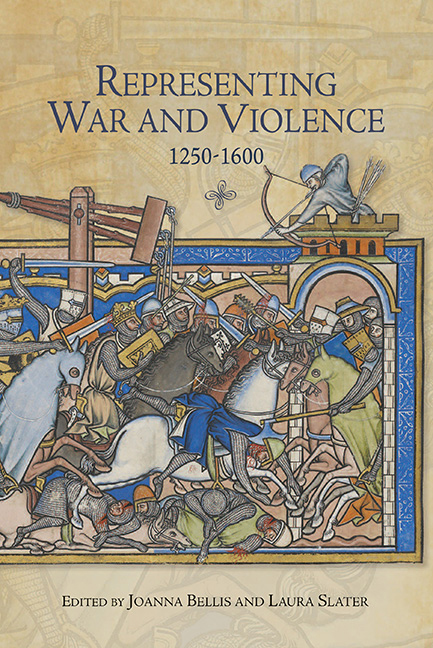Book contents
- Frontmatter
- Contents
- List of Illustrations
- Acknowledgements
- List of Contributors
- Introduction: ‘Representation’ and Medieval Mediations of Violence
- Part I The Ethics and Aesthetics of Depicting War and Violence
- 1 Medieval Warfare – Representation Then and Now
- 2 Depicting Defeat in the Grandes Chroniques de France
- 3 Visualising War: the Aesthetics of Violence in the Alliterative Morte Arthure
- Part II Debating and Narrating Violence
- Part III Experiencing, Representing and Remembering Violence
- Bibliography
- Index
3 - Visualising War: the Aesthetics of Violence in the Alliterative Morte Arthure
from Part I - The Ethics and Aesthetics of Depicting War and Violence
Published online by Cambridge University Press: 05 September 2016
- Frontmatter
- Contents
- List of Illustrations
- Acknowledgements
- List of Contributors
- Introduction: ‘Representation’ and Medieval Mediations of Violence
- Part I The Ethics and Aesthetics of Depicting War and Violence
- 1 Medieval Warfare – Representation Then and Now
- 2 Depicting Defeat in the Grandes Chroniques de France
- 3 Visualising War: the Aesthetics of Violence in the Alliterative Morte Arthure
- Part II Debating and Narrating Violence
- Part III Experiencing, Representing and Remembering Violence
- Bibliography
- Index
Summary
The Alliterative Morte Arthure has gained a critical reputation for being a particularly battle-focused Arthurian narrative, with a tendency toward the gratuitous display of wounding and excessive violence. While the text's chronicle sources and analogues make clear that the various military campaigns were indeed bloody and violent, they depict little of the visceral realities of hand-to-hand combat. The Morte Arthure, however, provides many finely realised descriptions of such action, which increase in intensity as the narrative moves into Arthur's final battle. This article aims to account for the aesthetic effect of these descriptions of the battlefield and the motivation for this particular narrative focus, by considering the text in its wider literary and cultural context, and the kinds of reading practices that may have been at play. My focus is on understanding the effect on the reader of the accumulation of bloody detail, rather than accounting for the political or ideological reasons for displaying explicit violence. Authors such as Geoffrey of Monmouth, Wace and La?amon were unflinching in enumerating acts of violence, but they did so with little attention to specific descriptive detail; the Morte Arthure, in contrast, provides many set-pieces that display an intimate engagement with wounded bodies and the wielding of weapons.
These accounts interrupt the larger narrative in a similar manner to other formulaic set-pieces in alliterative poetry of this period. Battle accounts, with their stylised detail and specialist vocabulary, are equivalent to descriptions of courtly arts and accomplishments such as clothing, tournaments, hunting and feasting; such language functions as an encoding of courtly ideals, marking out a sense of ownership and belonging for those versed in its particular details. Not all episodes within the text, however, operate in the same manner. The Siege of Metz, for example, is often described as representing excessive cruelty, but it is not visually shocking in its representation of acts of violence. Other narrative passages draw out the physical beauty of the battlefield, of armour, or of wounded bodies, at the same time that they depict acts of devastating violence. But, outside of the formulaic set-piece, there are other highly visualised descriptions that invite the imaginative engagement of the reader, where a shaft of sunlight might shine on a wounded body revealing its internal organs, or we see the progression of a sword splitting enamel, then silver, then velvet, before finally severing a vein and soaking everything with blood.
- Type
- Chapter
- Information
- Representing War and Violence, 1250-1600 , pp. 56 - 76Publisher: Boydell & BrewerPrint publication year: 2016



